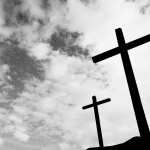
As we continue to consider the gospel call of bearing our crosses and the myth of redemptive suffering , I want to highly recommend the now-classic essay by Brown and Parker, “For God So Loved the World?” You can find a readable PDF of this essay at http://healingreligion.com/2490/pdf/forgodso.pdf. I’m grateful to healingreligion.com for providing this resource freely.
Welcome Readers! Please subscribe to Social Jesus Here.
(Read this series from its beginning here.)
The very first paragraph of Brown’s and Parker’s essay states:
“Women are acculturated to accept abuse. We come to believe that it is our place to suffer. Breaking silence about the victimization of women and the ways in which we have become anesthetized to our violation is a central theme in women’s literature, theology, art, social action, and politics. With every new revelation we confront again the deep and painful secret that sustains us in oppression: We have been convinced that our suffering is justified.”
For Christian women, the Christian traditional interpretation of the death of Jesus as redemptive serves to promote the harmful and death-dealing teaching that suffering is or can be redemptive. I’m reminded of the words of Katie G. Cannon in the foreword to the 25th anniversary edition of Delores S. Williams’ Sisters in the Wilderness: The Challenge of Womanist God-Talk:
“[Williams] contends that theologians need to think seriously about the real-life consequences of redemptive suffering, God-talk that equates the acceptance of pain, misery, and abuse as the way for true believers to live as authentic Christian disciples. Those who spew such false teaching and warped preaching must cease and desist.”
Space here does not permit me here this week to critique various atonement theories and present alternatives (I have done this elsewhere). I do want to offer some guidance this week with the specific passage we are considering.
Too often, the cross we are to counseled to “bear” is defined as an injustice itself. When we define the injustice or abuse we are suffering as our cross to bear, then being Christlike leads to being passive and patiently enduring whatever injustice or abuse we are suffering.
But this is not what the cross stood for in the Jesus story of the synoptic gospels. In that story, Jesus begins the week with a protest where he flips the tables of the money changers in the temple courtyard. We have to understand the context to see why.
In the time of Jesus, the poor and marginalized were being crushed under the Temple State’s complicity with the Roman Empire’s extractive economy. The poor were getting poorer and farmers were losing their land through growing indebtedness to the rich and wealthy class. Even in our reading this week, Jesus sets his sights on the heart of the Temple State in Jerusalem, the temple, and determines he must demonstrate there against the abuses that were going on. The rest of that week in these gospels, we witness the system pushing back. That doesn’t result in Jesus’ redemptive death, but in his unjust state execution for speaking out. In the story, the Divine overturns the injustice three days later. Everything accomplished through the death of Jesus was reversed, undone, and overcome through Jesus being brought back to life.
Next, we’ll consider what this might mean for our own speaking out today.
(Read Part 3)
Are you getting all of RHM’s free resources each week?
Begin each day being inspired toward love, compassion, action, and justice. Free
Sign-Up here:














